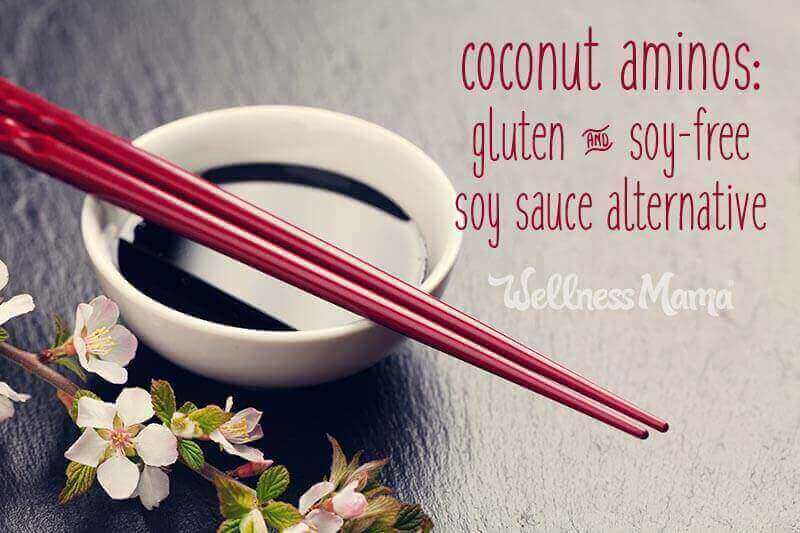Health-conscious people (like us!) often choose to eliminate soy from their diets. I love my stir fries and Asian-influenced dishes, so soy sauce is one staple I’d often miss.
Thankfully, coconut aminos offer a tasty and even healthier alternative to soy sauce. If you’re already convinced, jump below to read about their benefits and how to use them in your family’s meals.
If not, read on!
Why Not Soy Sauce?
I’ve said before that if you’re going to consume soy you should choose fermented versions. Fermenting increases digestibility and has benefits that help negate some of soy’s harmful effects.
Since soy sauce comes from fermented bean paste, why am I still suggesting an alternative? Here are a few reasons:
It’s a Common Food Allergen
Many people react to soy whether it is fermented or not. Soy sauce often also contains wheat (gluten), another common allergen. (Coconut aminos is always gluten-free.)
It’s High in Sodium
We all know soy sauce is salty, but just a few teaspoons contain more than half of the daily recommended sodium intake for an entire day! You can purchase reduced sodium varieties, but coconut aminos (my recommended alternative) naturally contains 75% less salt than soy sauce.
It’s Often a Source of MSG
Manufacturers commonly add coloring and chemical additives like MSG to enhance flavor or control saltiness. Consuming MSG can lead to migraine headaches, brain cell death, and impaired brain development in young children (source).
Commercial Soy Sauce Usually isn’t Made like Traditional Recipes
Traditional soy sauce ferments naturally for a long period of time and is served raw to preserve the beneficial enzymes. Most commercial producers use a much faster high-tech process called “rapid hydrolysis” that changes naturally occurring glutamates into “an unnatural form of glutamic acid that closely resembles MSG” (source). Certain quality brands stick to more traditional methods, so do your research.
Enough with the bad stuff … enter coconut aminos!
The Many Benefits of Coconut Aminos
Ten years ago coconut products weren’t on most people’s radar, but today the market abounds with alternatives boasting the health benefits of coconuts.
Coconut aminos looks just like soy sauce and has a very similar flavor, though some describe it as more complex and having a more rounded flavor profile than soy sauce. It is made from the sap of the coconut tree, mixed with salt and aged to create a flavorful brew.
Coconut sap, the key ingredient in coconut aminos, offers many health benefits.
Low GI Scale
Although naturally sweet, coconut sap (and coconut aminos) rings in at a low 35 on the GI scale, so it won’t spike your blood sugar.
Protective Cancer-Fighting Effects
Not only does coconut sap support healthy insulin levels and glucose metabolism, studies show it can have a protective effect on the kidneys. It also contains inositol, a B vitamin complex component that research suggests could help ward off prostate cancer.
Nutrient-Rich and pH-Balanced
Coconut sap contains a wide variety of minerals, vitamins, and amino acids (more on that in a minute), including high levels of potassium, vitamin C, and B vitamins (source). Its neutral pH also helps balance the body and make it alkaline.
(Almost) Complete Amino Acid Profile
Twenty different amino acids make up the proteins in our body. They function as the building blocks of life and are necessary for muscle development and brain health.
Our body can create some of these amino acids on its own, but 9 essential amino acids have to come through diet. Growing babies and children need all of the essential aminos, but they also need arginine, cysteine and tyrosine. Those who aren’t able to properly synthesize certain amino acids well because of genetics or age usually also need what are called conditionally essential amino acids (source).
Coconut sap and aminos have all 9 essential amino acids and 5 out of 7 of the conditionally essential amino acids, as well as a few others to help our bodies out. The sap also contains the amino acid glutamine, which doesn’t turn into MSG since coconut aminos isn’t fermented with a bacteria or yeast.
And that’s not it for good news!
Sustainably Produced
Interestingly enough, coconut trees do not produce coconuts when tapped for sap, since the sap is collected from the coconut blossoms before they mature. As a result some controversy exists about the sustainability of tapping coconut trees.
The Food and Agriculture Organization (FAO) of the World Bank and the Davao Research Center affirm tapping coconut trees for sap as an age-old and highly sustainable practice. For more on this topic, see this helpful article.
Now that you know about coconut aminos, put them to use in your kitchen today!
Where to Get Coconut Aminos
You can often find it at your local grocery or health food store, but if they don’t carry this versatile condiment yet, you can also order it online like I do. 🙂
How to Use Coconut Aminos
Use coconut aminos in any recipe that calls for soy sauce. Avoid heating coconut aminos, as heat destroys the (natural and good) glutamine content. When you’re cooking, simply add them at the end of the recipe if possible.
Here are Some Recipe Ideas to Get You Started!
Healthy Vegetable Fried “Rice”
Meatball Shish Kabobs
Beef and Broccoli Stir Fry
Sweet and Sour Chicken
Cashew Chicken Lettuce Wraps
Grilled Thai Shrimp
Healthy Mandarin Chicken
Have you tried coconut aminos? If not, do you think you will try it?




Leave a Reply